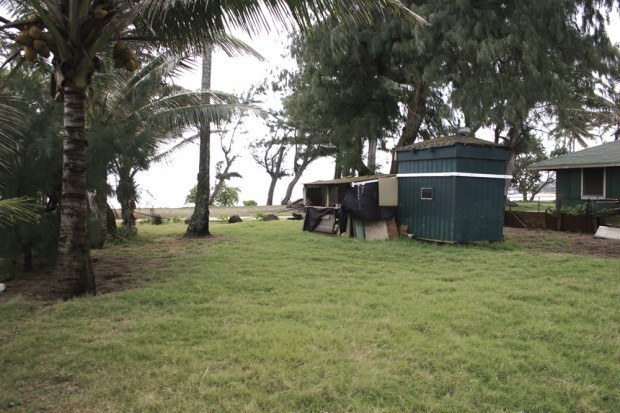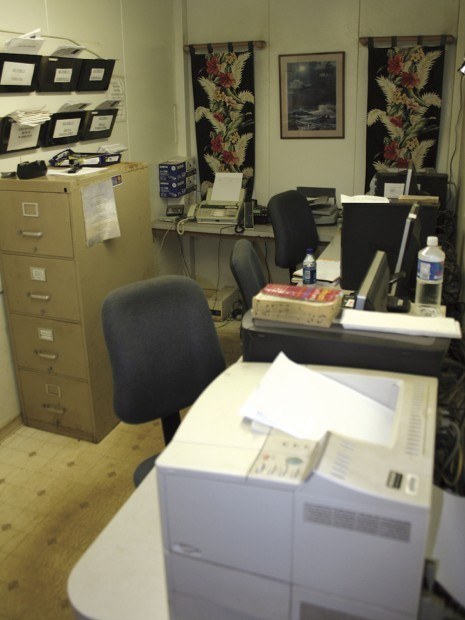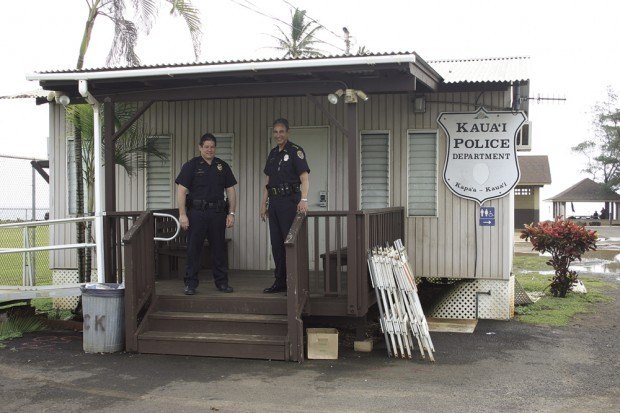KAPA‘A — Visitors to the Kaua‘i Police Department’s Kapa‘a substation ask officers to pose for photos with them in front of the storage-shed-sized facility, unable to believe it is actually an office. At around 350 square feet, it is probably
KAPA‘A — Visitors to the Kaua‘i Police Department’s Kapa‘a substation ask officers to pose for photos with them in front of the storage-shed-sized facility, unable to believe it is actually an office.
At around 350 square feet, it is probably smaller than some back-yard storage sheds.
When The Garden Island visited the facility Tuesday, KPD Lt. Michael Contrades was waiting outside, and the reporter thought he was dutifully waiting outside for KPD Chief Darryl Perry and the reporter to arrive.
No, he was waiting outside because a detective was conducting an interview inside, and there was no other space inside the cramped substation for Contrades to stay without disrupting the detective’s police work.
It has been that way for 10 years, since the “temporary” substation, formerly a post-hurricane shelter gifted to the county, was put on the site off Kuhio Highway at the Kapa‘a Beach Park.
Now, KPD officials have their eyes on a 7,000-square-foot parcel closer to the water, adjacent to Kapa‘a Beach Park and owned by the state Department of Land and Natural Resources, and have been negotiating for a right-of-entry and executive order in order to put a new, temporary structure on the property.
“The land is free. That was a big plus,” said Contrades, adding that the parcel has sewer, water and electric available.
He envisions another temporary structure of around 1,400 square feet, with public and officer entrances (the existing substation has one way in and one way out, which can make for dangerous conditions for officers, Perry said), a surveillance system to monitor the nearby Kapa‘a Beach Park pavilion and restroom areas and the section of coastal path which would front the new temporary substation, and much more room for the officers to write reports, interview victims and suspects, book those arrested, and have room for storage of traffic cones, signs and other paraphernalia currently stored in the shower stall of the existing temporary substation.
The existing temporary substation does not have enough room to house an electronic mug-shot and fingerprinting system, so only juveniles are allowed to be arrested in the substation, and photographed and fingerprinted manually, said Contrades and Perry.
But the DLNR property might be further down than the road than the distance from the substation to the DLNR parcel, according to a DLNR spokesperson.
“We understand the county has been having internal discussions and that this is still in preliminary stages,” said Deborah Ward, DLNR information specialist.
“DLNR has not received any formal request at this date, but we are aware of the discussions,” she said.
“We have a lot of issues with the Kapa‘a substation,” including the fact that the windows are too small to be utilized as fire escapes in the event of a fire, said Contrades.
The KPD officials want to keep the Kapa‘a substation in a central location in order to maximize response times, and it is envisioned that the new temporary substation would continue to be the parking area for the Eastside fleet, Contrades said.
A majority of the officers assigned to the district, which stretches from Kapa‘a to Ha‘ena, live in Wailua, Kapa‘a or Anahola, making it convenient for them to report to the Kapa‘a substation to pick up vehicles, thus avoiding a trip all the way into Lihu‘e, said Contrades.
In the not-too-distant future, KPD will require “real” substations in Kapa‘a and Waimea, similar to the one at Princeville shared by the Kaua‘i Fire Department, Perry said.
Contrades said KPD is requesting use of asset-forfeiture funds for the new, temporary Kapa‘a substation, so no taxpayer money will need to be used for the new facility.
Asset-forfeiture funds are cash and assets taken from convicted criminals, and can only be used for law-enforcement purposes, he said.
Use of such funds requires approval of the County Council, mayor and county finance director.
The temporary substation closer to the beach would cost around $300,000, and include a modular building, fencing, surveillance system, furniture, storage area and other amenities, he said.
There is much more than $300,000 in the asset-forfeiture fund, Perry said. By law, 50 percent of asset-forfeiture funds go to the state, 25 percent to the county prosecutor’s office and 25 percent to KPD.
“We have enough funds in there to cover right now,” Perry said. “It’s good for the community that we have these funds available” for this “dire need.”
Currently, if large meetings need to be scheduled, the Kapa‘a Neighborhood Center or Hawai‘i Army National Guard armory are utilized, because there simply is not enough room at the substation, said Contrades.
A permanent substation would include holding, booking, meeting and fitness areas.
A larger temporary substation would also save those arrested who make bail from having to travel to Lihu‘e, and would function also to keep officers assigned to the district in the district, said Contrades.
It is envisioned that the new temporary substation would be in place for five to six years, with KPD looking at land near the Kapa‘a Middle School, owned by a willing seller, for its permanent Kapa‘a substation, Contrades said.
Currently, there is no staff assigned permanently at the Kapa‘a substation, in part because there isn’t enough room. So if a walk-up comes seeking assistance and no officer is on-premises, they are directed to call KPD dispatch, and an officer meets them at the substation, said Contrades.
Originally, the current temporary Kapa‘a substation was placed at the Kapa‘a Beach Park as a place for officers to write reports, said Contrades. Over time, it became a place for people to go looking for police assistance as well, he said.
Perry said Contrades has “been the mover and shaker on this project,” handling the logistics of setting up the new temporary substation while maintaining his duties as Hanalei district commander.
“Mike has stepped up to the plate, thank goodness,” Perry said.
The chief has been “fully behind it, fully supportive; couldn’t ask for anything more,” said Contrades.
Perry said Mayor Bernard P. Carvalho Jr. has been supportive of Perry’s efforts to establish new, permanent substations at Kapa‘a and Waimea, which need to be built to exacting specifications in order for KPD to achieve national accreditation.
“We’ve recognized for several years now that we needed to expand, but it takes time. In fact, they’ve (officers assigned to Kapa‘a) endured a lot,” said Contrades.




